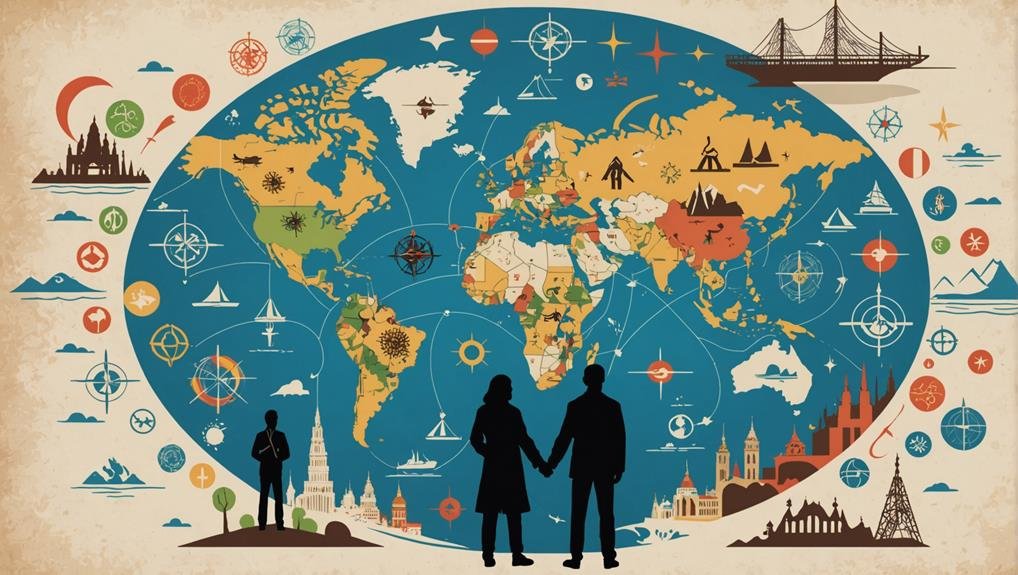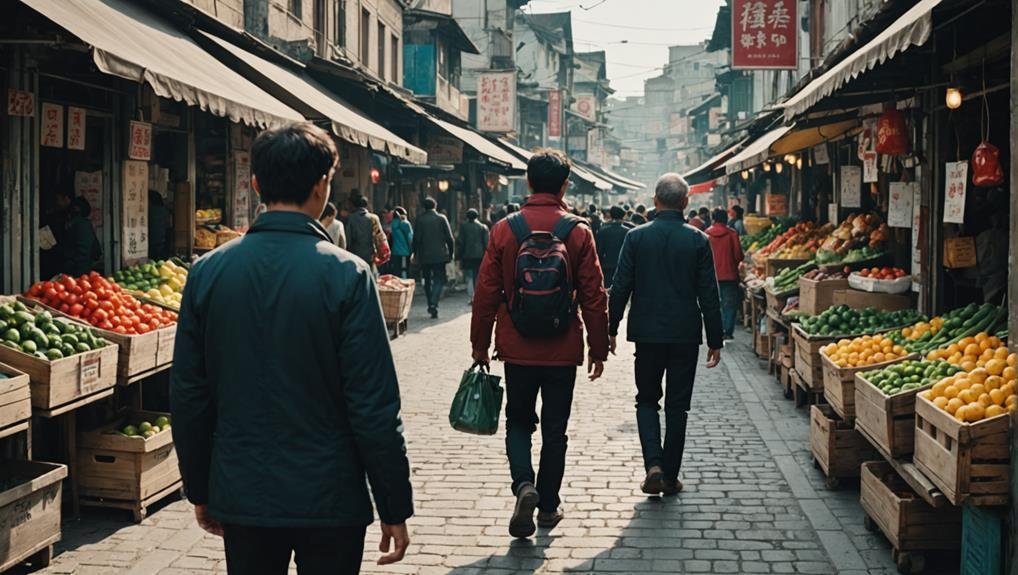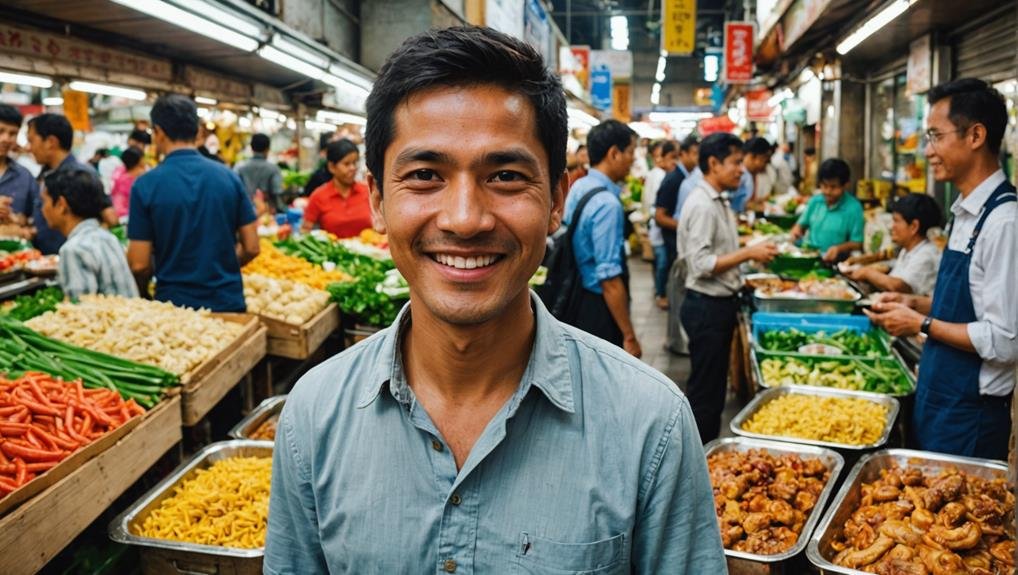When you relocate to a new country, you might grapple with culture shock, feeling lost and overwhelmed by unfamiliar customs and social norms. However, this initial disorientation is just the beginning of a transformative journey. As you navigate these challenges, cultural adaptation gradually takes place, allowing you to integrate and thrive in your new environment. Understanding the stages of this process can help you better prepare and cope. But what exactly are these stages, and how can you effectively shift from culture shock to adaptation? Learn more about Cultural Shock Vs. Cultural Adaptation.
Key Takeaways
- Culture shock involves feelings of anxiety and disorientation when exposed to an unfamiliar culture.
- Cultural adaptation is gradually adjusting and becoming comfortable in a new cultural environment.
- Culture shock phases include honeymoon, rejection, recovery, and acceptance.
- Effective coping mechanisms, such as learning the language and joining community groups, aid cultural adaptation.
- Cultural adaptation results in increased self-confidence, cultural sensitivity, and cross-cultural communication skills.
Understanding Culture Shock

Experiencing culture shock is a natural part of living abroad, unfolding through several distinct phases. Initially, you’ll find yourself in the honeymoon stage, where everything about your new environment seems exciting and captivating. However, this euphoria soon gives way to frustration.
This phase can be challenging as the novelty wears off, and cultural differences become glaring obstacles. Acknowledging and accepting your frustration or sadness is pivotal during this period.
As you navigate through these stages, you’ll enter the adjustment phase. Here, you develop coping strategies that make daily life more manageable. Keeping a positive attitude, reflecting on personal growth, and being patient with yourself are effective ways to ease this shift. It’s a time to embrace the cultural experience and learn from it.
Support from friends, family, and communities can greatly aid in the adjustment process. They can provide an invaluable sense of familiarity and comfort.
The final stage of culture shock is acceptance. You come to terms with the new culture, even if you don’t fully understand every aspect. You’ve integrated enough to feel comfortable in your new surroundings by this point.
Factors Influencing Culture Shock
When you experience culture shock, several factors come into play, such as cultural differences, your expectations, and the support you receive. The intensity of this shock often depends on how unfamiliar the new culture is to you and your adaptability. Understanding these factors can help you better prepare and manage the challenges of living abroad.
Influencing Shock Factors
Numerous factors play a pivotal role in influencing culture shock. When you move to a new country, language barriers can be one of the most immediate challenges. Not being able to communicate effectively can make everyday tasks challenging. Social norms and customs that differ from what you’re used to can also be bewildering, creating a sense of disorientation.
Another major factor influencing culture shock is food. Unfamiliar cuisine can be exhilarating but unsettling, especially if it differs from your usual diet. Climate changes and variances in communication styles can further add to your discomfort.
For instance, what’s considered polite or rude can vary widely between cultures.
Your expectations and previous travel experience also play a role. If you’ve traveled extensively, you might find adapting easier. On the other hand, if you’re more culturally aware, you might better anticipate and navigate potential challenges.
Coping mechanisms are essential in managing culture shock. Developing a support system and staying flexible is vital. Understanding the cultural differences in values, beliefs, and traditions can help you better prepare and lessen the intensity of the shock. Being proactive in learning about your new environment can greatly ease the Adjustment.
Degree of Shock
The degree of cultural disorientation can vary greatly based on multiple factors, including cultural distinctions between your home country and the host country. If these distinctions are extensive, you will likely experience more intense cultural disorientation. Your individual experiences and intercultural skills also play a significant role. For instance, if you’ve previously lived in different countries or have a strong understanding of diverse cultures, you might find the adaptation process smoother.
Cultural disorientation has distinct stages that impact individuals differently. Initially, you might feel excited and curious, but frustration and confusion can arise as the distinctions become more apparent. This challenging process can affect your psyche, making the adaptation process overwhelming. However, overcoming cultural disorientation is essential for cultural adaptation and personal growth.
To navigate these challenges, you must change your behaviors and thoughts to align with the new cultural context. This might involve learning the local language, understanding social norms, and building new relationships. By embracing these changes, you reduce the degree of cultural disorientation and enhance your ability to adapt and thrive in a new environment.
Symptoms of Culture Shock

When you’re experiencing culture shock, it can feel like an emotional roller coaster, with bouts of homesickness, sadness, and irritability.
You might also withdraw socially, avoiding interactions that once felt natural. Recognizing these symptoms is the first step toward managing them effectively.
Emotional Roller Coaster
Traversing the emotional roller coaster of culture shock can be challenging. You might feel anxiety, disorientation, and confusion as you adjust to a new cultural environment. These symptoms can manifest as changes in your daily habits, homesickness, or irritability. Recognizing that these feelings are a normal part of the process can be key to managing them effectively.
The emotional roller coaster of culture shock often includes:
- Anxiety and Disorientation: Feeling lost or out of place in unfamiliar surroundings.
- Homesickness and Irritability: Missing home comfort and getting easily frustrated with new situations.
- Hostility and Sadness: Experiencing negative emotions towards the new culture and feeling down.
Coping strategies are essential to navigating these tumultuous emotions. Understand that these unpleasant feelings are temporary and won’t last forever. Self-awareness can help you identify when you’re experiencing culture shock and remind you that it’s okay to seek support.
Talking to others who’ve gone through similar experiences or engaging in familiar activities can alleviate some stress. Embrace the journey with patience and an open mind, knowing that adaptation takes time.
Social Withdrawal Signs
Many individuals experiencing culture shock exhibit signs of social seclusion, which can greatly impact their adjustment process. You might notice that you’re avoiding social interactions, secluding yourself, or feeling disconnected from those around you. These social seclusion signs are common symptoms of culture shock and represent a coping mechanism for adapting to a new environment.
Social Seclusion Signs in Culture Shock
| Symptom | Description |
|---|---|
| Avoiding Social Interactions | You might be hesitant to engage in conversations or group activities. |
| Isolating Oneself | Spending more time alone and avoiding social events can become a frequent behavior. |
| Feeling Disconnected | I am experiencing a sense of detachment from others, leading to minimal interaction. |
Recognizing these symptoms is vital. Reduced communication and a general sense of detachment can make the adjustment process even more challenging. You may feel a strong urge to withdraw from social events, which can amplify feelings of isolation and loneliness. Addressing these signs of social seclusion early on can help you overcome the discomfort and better adapt to your new cultural setting. Engaging in small social activities and seeking support can effectively combat these symptoms and ease your shift.
The Honeymoon Phase
Entering a new culture often brings enthusiasm and optimism, known as the Honeymoon Phase. You might be in awe of the new environment, captivated by the differences, and keen to explore. This phase is marked by euphoria and fascination, where you focus on the positive aspects and overlook potential challenges.
During the Honeymoon Phase, you’ll likely experience:
- Enthusiasm: Everything feels new and intriguing, from the food to the customs.
- Optimism: You feel hopeful and positive about your ability to adapt and thrive.
- Curiosity: You’re eager to learn and immerse yourself in the new culture, asking questions and seeking new experiences.
This initial stage of cultural adaptation sets a positive tone, laying the foundation for the adaptation process. It’s a common experience and a period of heightened exploration where you might feel like you’re on an extended vacation. Embrace this enthusiasm and optimism as it helps you build a deeper connection with the new culture.
While the Honeymoon Phase is exhilarating, remember it’s just the beginning. This phase will set the stage for what comes next in your journey of cultural adaptation.
The Rejection Phase

Entering the Rejection Phase, you might find yourself on an emotional rollercoaster, grappling with hostility and confusion. Coping mechanisms become essential as you navigate homesickness and irritability, trying to make sense of the new culture. This phase also challenges your identity, making you question your place and values in unfamiliar surroundings.
Emotional Rollercoaster
Traversing the Rejection Phase of cultural shock can feel like an emotional rollercoaster. It is characterized by feelings of anxiety, disorientation, and confusion in a new cultural environment. During this phase, you might notice changes in your habits, experience homesickness, and become more irritable as you struggle to adapt. The duration of this phase varies from person to person, influenced by factors like self-awareness and how long you plan to stay.
Common emotions you might face include:
- Anxiety: Constantly feeling on edge due to the unfamiliar surroundings.
- Hostility: Developing negative feelings toward the new culture as a defense mechanism.
- Sadness: Experiencing a sense of loss for the familiar comforts of your home culture.
These emotions can lead to self-doubt and overwhelm. It is vital to recognize these feelings as part of the cultural adaptation process.
Although you’ll naturally seek coping strategies, avoid isolating yourself. Reaching out to friends, family, or counselors can support you. Engaging in self-care practices, like maintaining a routine or exploring new hobbies, can also help ease your adjustmenAdjustmentMechanisms
Dealing with the Rejection Phase of cultural adaptation means you’ll need effective Adjustments to navigate the emotional turbulence. During this phase, you might feel anxiety, disorientation, and confusion as part of cultural shock. It’s common to experience changes in habits, homesickness, irritability, and even hostility towards the new culture. These feelings can make you sad, doubtful, and overwhelmed.
Identity Challenges
While coping mechanisms are essential for managing the emotional turbulence of cultural shock, another significant challenge during the Rejection Phase is the impact on your identity. You might feel disoriented and confused as you navigate a new cultural environment, leading to self-doubt and sadness. This phase, marked by homesickness and irritability, can make you question your sense of self and where you belong.
Identity challenges during this phase can be overwhelming, but understanding them is the first step. Here are three key aspects to keep in mind:
- Self-awareness: Recognize that your feelings of hostility or sadness are normal and a part of your adaptation process.
- Changes in habits: Notice how your daily routines have shifted and how this affects your sense of identity.
- Seeking support: Don’t hesitate to contact friends, family, or support groups who understand your experience.
The Recovery Phase
The Recovery Stage, which follows the intense Crisis Stage of culture shock, signifies a gradual adjustment to your new environment. You’ll begin to experience heightened self-assurance and cultural awareness, which will help you navigate your new surroundings more smoothly. Throughout this phase, social exploration becomes essential.
You’ll notice yourself becoming more at ease exploring, meeting new individuals, and immersing yourself in the local culture. This newfound confidence helps you feel less like an outsider and more like a community member.
Self-care activities play a vital role in smoothing this Adjustment. Adjusting to a routine, pursuing hobbies, or simply taking time to unwind enhances one’s well-being. Staying connected with home through regular calls or messages can also offer emotional comfort and stability.
Seeking support from friends, family, or counselors can be extremely advantageous. They can provide advice, share their experiences, and lend a sympathetic ear, reducing feelings of isolation. The Recovery Stage is a period of development and adjustment, when you adjust to strike a balance between your original culture and the new one, setting the stage for an adjustment-enriching experience abroad.
Strategies to Diminish Culture Shock

Experiencing culture shock can be overwhelming, but there are effective strategies to help ease your adjustment. The adjAdjustmentthod involves immersing yourself in the host culture. This means participating in local traditions and trying to Adjust the language. By doing so, you’ll feel more connected and less like an outsider. Keeping an open mind is pivotal during this process. Embrace new experiences and view them as opportunities for growth rather than challenges.
Here are three strategies to diminish culture shock:
- Join local groups or activities: Engaging in athletic activities or joining clubs can provide a sense of familiarity and belonging. Whether it’s a sports team or a hobby group, these activities can help you connect with others and create a new support system.
- Build connections: Form relationships with both locals and fellow expats. These connections can offer invaluable support and provide different perspectives that help you navigate your new environment more easily.
- Maintain support from home: Stay connected with friends and family back home. Regular communication can provide emotional support and a sense of stability. If needed, seek counseling to help cope with the emotional aspects of culture shock.
Using these strategies can make your adjustment adjustment more enjoyable.
Real-Life Experiences
Traveling through the waters of cultural shock can be an adjustment, but hearing real-life experiences can make a world of difference. Personal narratives provide insights into the adaptation process, helping you understand that you’re not alone. These stories reveal the emotional journey from initial shock to eventual adaptation, illustrating effective coping strategies.
Consider the table below, which showcases the experiences of different individuals:
| Name | Initial Challenge | Coping Strategy |
|---|---|---|
| Maria | Language barrier | Language classes |
| John | Homesickness | Socializing with locals |
| Aiko | Cultural misunderstandings | Cultural immersion |
| Ahmed | Unfamiliar food | Exploring local cuisine |
| Sophie | Isolation | Joining community groups |
Maria struggled with the language barrier but found relief through language classes. John’s homesickness eased as he socialized with locals, while Aiko tackled cultural misunderstandings by immersing herself in local traditions. Ahmed embraced unfamiliar food, making it an opportunity to explore regional cuisine. Sophie, feeling isolated, joined community groups to build connections.
These real-life examples highlight the resilience and personal development of facing cultural shock head-on. By learning from others’ experiences, you can better navigate your adaptation process, making your journey smoother and more enriching.
Preparing for Cultural Transition

Exploring cultural adjustment: Understanding the stages of culture shock and cultural adaptation. Preparing for a cultural shift involves familiarizing yourself with the phases of cultural adjustment, such as adjustment, mourninAdjustment recovery, and adjustment. AdjustiAdjustmenttages helps you anticipate adjustment expectations and equips you with strategies to adjust yourself effectively; consider the following steps:
- Educate Yourself: Learn about the new culture, including customs, values, and social norms. This knowledge can minimize surprises and reduce the intensity of cultural disorientation.
- Practice Self-Care: Engage in activities that promote your well-being, such as exercising, meditating, or journaling.
It’s important to understand that cultural adaptation is a unique journey for each individual. Embrace the process with patience and an open mind, knowing there will be both highs and lows. By preparing yourself mentally and emotionally, you’re setting the stage for a smoother shift and successful cultural adjustment.
Adapting to a new culture brings many benefits that extend bAdjustment survival in a new environment. When individuals experience cultural adaptation, they often find their self-confidence soaring. You’ll become more comfortable exploring unfamiliar settings, boosting your self-esteem.
Cultural adaptation also makes you more culturally sensitive. By adjusting your behaviors and thinking patterns to fit a new cultural context, you develop a heightened awareness of different customs and traditions. This sensitivity can foster empathy and improve your cross-cultural communication skills, making interactions smoother and more meaningful.
Conclusion
You’ll encounter culture shock in exploring a new culture, but don’t let it overpower you. Embrace the journey toward cultural adaptation. By grasping the phases and utilizing effective strategies, you can smoothen the change and flourish in your new environment. This process enhances resilience and self-confidence and enriches your viewpoint, nurturing a deeper gratitude for diversity. So, leap and uncover the growth that awaits you.
FAQs
1. What Is Adaptation in Culture Shock?
Adapting to culture shock means overcoming challenges, changing behaviors, and developing coping strategies. You’ll experience phases like honeymoon, crisis, recovery, and adjustment, which boost self-confidence and cultural sensitivity. Adjustments An Example of a Cultural AdapAdjustmentu might learn the local language to communicate more effectively. This adaptation helps you navigate daily life, build relationships, and feel more connected. Embracing local customs and social norms enhances your integration into the new culture.
3. What Is an Example of a Cultural Shock?
When you move to a country where people don’t use personal space similarly, you might experience culture shock. You could feel uncomfortable or anxious when locals stand too close during conversations.
4. What Are the 4 Stages of Culture Shock?
You’ll experience four stages of culture shock: honeymoon, where everything feels exciting; crisis, marked by confusion and frustration; recovery, as you adapt; and Adjustment, where you finally feel comfortable and integrated.

